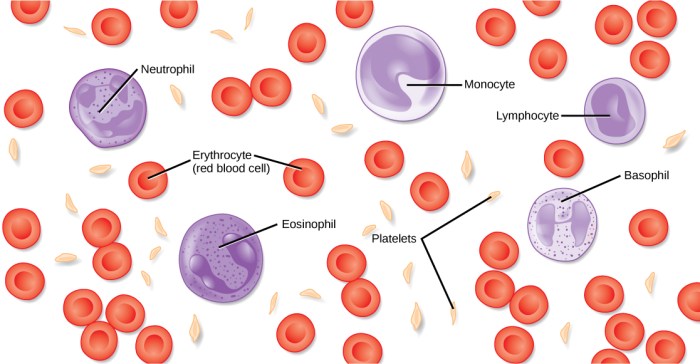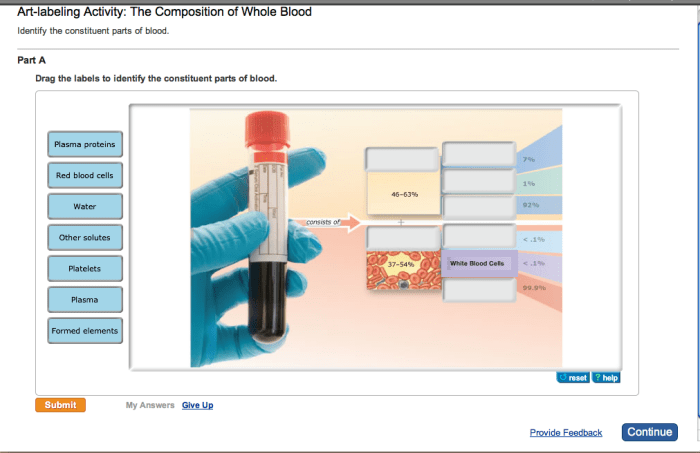Embark on an illuminating journey with the art-labeling activity: components of blood. This captivating exploration delves into the intricacies of blood’s composition, revealing the fundamental roles played by its diverse elements within the circulatory system. Join us as we uncover the principles and applications of labeling techniques, unraveling the mysteries of blood components and their significance in medical research and diagnostics.
Through this interactive experience, you will gain a comprehensive understanding of the various blood components, including red blood cells, white blood cells, and plasma. We will explore their specific functions, examining how they contribute to the maintenance of homeostasis and the overall health of the body.
Blood Components: Types and Functions

Blood is a complex fluid that consists of various components, each with specific functions within the circulatory system. These components include red blood cells, white blood cells, and plasma.
Red blood cells are responsible for carrying oxygen from the lungs to the body’s tissues and organs. They contain hemoglobin, a protein that binds to oxygen molecules and facilitates their transport. White blood cells play a crucial role in the immune system by defending the body against infections and foreign substances.
Plasma is the liquid component of blood that carries nutrients, hormones, and waste products. It also contains clotting factors that are essential for blood coagulation.
Labeling Methods for Blood Components
Various labeling techniques are employed to label blood components for research and diagnostic purposes. These methods include:
- Fluorescent labeling:Involves using fluorescent dyes that emit light when exposed to specific wavelengths of light. This method allows for the visualization and tracking of labeled cells in real-time.
- Magnetic labeling:Utilizes magnetic nanoparticles that bind to blood components. Magnetic fields can then be used to manipulate or isolate the labeled cells.
Applications of Blood Component Labeling
Labeled blood components are widely used in medical research and diagnostics. Some applications include:
- Tracking cell migration:Labeled cells can be tracked in vivo to study their migration patterns and interactions with other cells.
- Identifying disease markers:Labeled blood components can be used to identify specific biomarkers associated with diseases, aiding in diagnosis and monitoring.
Advantages and Limitations of Blood Component Labeling

Using labeled blood components offers several advantages:
- Improved accuracy:Labeling allows for precise identification and quantification of specific blood components.
- Enhanced sensitivity:Labeled components can be detected with high sensitivity, enabling the detection of rare or low-abundance cells.
However, there are also some limitations:
- Potential interference:The labeling process may interfere with the normal function of blood components.
- Technical challenges:Labeling methods can be technically challenging and require specialized equipment and expertise.
Design Considerations for Blood Component Labeling Experiments
When designing experiments involving blood component labeling, several factors should be considered:
- Labeling efficiency:The efficiency of the labeling process is crucial to ensure sufficient labeling of the target cells.
- Specificity:The labeling method should be specific to the target blood component to avoid cross-reactivity with other cells.
- Potential interference:The potential impact of the labeling process on the function and viability of the blood components must be assessed.
Future Directions in Blood Component Labeling

Advancements in blood component labeling technologies are ongoing, with emerging trends including:
- Multiplex labeling:Techniques that allow for the simultaneous labeling of multiple blood components with different labels.
- Non-invasive labeling:Methods that enable labeling of blood components without the need for invasive procedures.
These advancements have the potential to further enhance the accuracy, sensitivity, and applicability of blood component labeling in medical research and diagnostics.
User Queries: Art-labeling Activity: Components Of Blood.
What is the purpose of labeling blood components?
Labeling blood components allows researchers and clinicians to track and identify specific cells or molecules within the blood. This enables them to study cell migration, identify disease markers, and develop targeted therapies.
What are the different types of labeling techniques used for blood components?
Various labeling techniques are employed, including fluorescent labeling, magnetic labeling, and radioactive labeling. Each method utilizes specific tags or markers to bind to the target molecules, allowing for their detection and analysis.
How are labeled blood components used in medical research?
Labeled blood components serve as valuable tools in medical research, enabling scientists to investigate disease mechanisms, develop new diagnostic tests, and evaluate the effectiveness of novel therapies.

